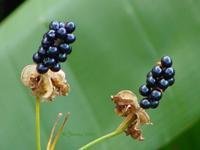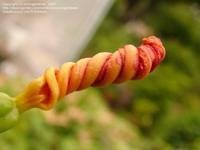





If blackberry lilies and candy lilies are not lilies then what are they? More important, do you need them in your garden?
(Editor's Note: This article was originally published on May 14, 2010. Your commetns are welcome, but please note that authors of previously published articles may not be able to respond to your questions.)
Blackberry lilies and candy lilies- I've seen them in catalogs and passed them by, but why? Phrases like "long midsummer bloom period, easy to grow, hardy perennial from seed, attractive dried seedheads" make these "lilies" sound like dream plants. In reality not every plant is suitable for every garden's conditions, or gardener's tastes. When a candy lily article was suggested, I volunteered to delve into these seed-grown lilies.
A beautiful lily; picture provided by DG subscriber "turektaylor"
Most commonly seen Blackberry lilies (Belamcanda chinensis) are a native flowering species from Asia, with a long history of use in traditional Chinese medicine. Once commercialized, blackberry lilies became popular enough, and grew easily enough, that they're now a widespread wild flower in eastern North America. Their simple shaped flowers bloom in orange accented by a complex pattern of darker flecks. Some call the plant leopard lily because of those spots. Multiple flowers emerge daily on top of tall open branched stems coming from a base of long iris like foliage. After weeks of bloom, seed pods form and open to reveal blackberry like seed clusters. The "blackberries"can be used as everlastings in dried arrangements. Technically, blackberrry lilies aren't so much a lily as they are an iris. Even the name has been changed to protect the innocent gardener from confusion. The older Latin name Belamcanda chinensis has officially been replaced with a new one, Iris domestica. Not as widely sold is the yellow Blackberry lily (Belamcanda flabellum); you might read the cultivar name 'Hello Yellow.' This close cousin has a clear yellow bloom and more compact form, and also grows the trademark faux-blackberry seed heads.
Not as widely sold is the yellow Blackberry lily (Belamcanda flabellum); you might read the cultivar name 'Hello Yellow.' This close cousin has a clear yellow bloom and more compact form, and also grows the trademark faux-blackberry seed heads.
Blackberry lily seed heads; picture from Plantfiles, courtesy of DG Uber "floridian'
Candy lilies mimic Blackberry lilies but display a wider range of color bloom. Samuel Norris (who, among other accomplishments, also discovered a unique crested iris and worked with pawpaw hybridization) created an unusual hybrid between blackberry lilies and a Vesper iris. (He must not have been fooled by the lily name.) Mr. Norris' new species got the name Pardancanda x norrisii, (now Iris x norrissii) and for some time was only commercially sold by Wayside Gardens. Growing Candy lilies from seed should give you a variety of clear, bicolored, and freckled flowers in yellows, reds, oranges, purples and white. The photo at the top of this article shows the bicolor effect.
Problematic as they may seem, what with the name changes, these "lilies" are said to be carefree in the garden. All are available as seed, making them an economical perennial choice. However, germination can be unpredictable with these seeds. Some growers claim easy germination from deeply planted whole seed heads, while others recommend stratification. Here's one recommended method for cold-treating these seeds. Soak the seed overnight before mixing with a small amount of moist potting mix. Put all of that in a plastic bag, Refrigerate the seed baggie for a week. Then make the seed soil mix the top layer in prepared starter pots at room temperature. Cover the pots with plastic and expect sprouts to emerge over a period of days or weeks. Fall harvested seed may be moistened and refrigerated for months, and should germinate well once planted.
Each flower wilts to a striking spiral shape; picture from PlantFiles courtesy DG subscriber "victorgardener"
 Once your seed sprouts you're pretty much home free. If you can grow common bearded iris, you can certainly grow "canda" lilies. These lilies grow well in average to rich soil and prefer full sun but don't much protest at a little shade. Young plants will develop large strap shaped leaves like familiar bearded iris, and may bloom in their first summer. While the leaves remind you of bearded riris, individual flowers are not as substantial: about an inch or so on blackberry lily, larger on candy lily. What they lack in size, canda lily flowers strive to make up in number. Blooms form on tall stiff sprays above the foliage. Since these lilies are in fact iris, watch them for iris problems, especially borers. Keep the soil surface and area at the base of the plant dry and don't mulch directly over the rhizomes of canda lilies, but do water in dry weather. As with Iris, growers recommend diving the plant every three years and replanting only the healthiest portions. For Candy lilies, keep the sections that bloom in the colors you prefer. All canda lilies can reseed, and Candy lilies tend to lose their color range when you allow random self seeding.
Once your seed sprouts you're pretty much home free. If you can grow common bearded iris, you can certainly grow "canda" lilies. These lilies grow well in average to rich soil and prefer full sun but don't much protest at a little shade. Young plants will develop large strap shaped leaves like familiar bearded iris, and may bloom in their first summer. While the leaves remind you of bearded riris, individual flowers are not as substantial: about an inch or so on blackberry lily, larger on candy lily. What they lack in size, canda lily flowers strive to make up in number. Blooms form on tall stiff sprays above the foliage. Since these lilies are in fact iris, watch them for iris problems, especially borers. Keep the soil surface and area at the base of the plant dry and don't mulch directly over the rhizomes of canda lilies, but do water in dry weather. As with Iris, growers recommend diving the plant every three years and replanting only the healthiest portions. For Candy lilies, keep the sections that bloom in the colors you prefer. All canda lilies can reseed, and Candy lilies tend to lose their color range when you allow random self seeding.
The more I read about these lilies that aren't, the more I am convinced I need to try them in my garden. In an odd coincidence, I may be doing just that already. Two years ago I planted some black seeds that were cryptically labeled "orange lily." I potted them and left them in the garden to acheive whatever natural stratification Mother Nature would decide to give them. Last year I found a dozen tiny sprouts in the pots. This spring those green ribbons have become decidedly iris like young plants. It will be an interesting and amazing quirk to find I already have Blackberry lilies after all.
~~~ ~~~ ~~~ ~~~ ~~~
Thanks again to DGer turektaylor, who was so helpful in giving the picture used at the top! Thanks also to victorgardener and floridian for use of their PlantFiles submissions.
My efforts to understand the whole Belamcanda/ Iris/Candy lily scenario were greatly aided by the website of SIGNA, Species Iris Group of North America, and Wayside Garden Voices newsletter, November 3, 2006.
Copyright © www.100flowers.win Botanic Garden All Rights Reserved